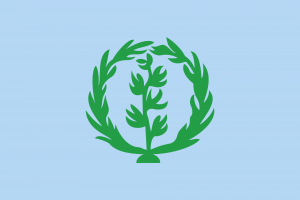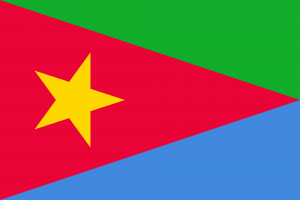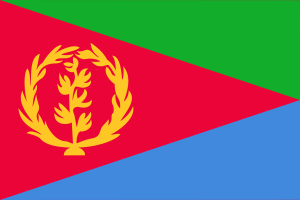This past weekend I was shocked to see the flag representing Eritrea during the Eritrean-Ethiopian Federal period flying. Even more peculiar to me was the fact that it was flying beside the modern Eritrean flag. I had never, in my life seen those two flags flown side-by-side, particularly because they represent mutually exclusive ideals. Of course, a brief introduction is necessary if you aren’t familiar with the 20th century history of Eritrea.
The Federal arrangement (the Federation) between Eritrea and Ethiopia was the ultimate result of a UN Commission Report on Eritrea which was reduced to UN General Assembly (UNGA) Resolution 390 (V). In general, the Federation was to be a pairing of two domestic governments under the sovereignty of the Ethiopian Emperor. In other words, ultimately the Ethiopian Emperor was the sovereign of Eritrea, in spite of the fact that the Federal arrangement was to be one of equals.
UNGA Resolution 390 (V) was known as the Federal Act and called for the creation of the Eritrean Constitution, which was approved in 1952. Article 21 of the 1952 Constitution of Eritrea identified that there would be a “Federal Flag” to be respected in Eritrea. ((Constitution of Eritrea (1952) )) In the same year the Eritrean Parliament adopted a flag representing Eritrea under the Federal arrangement. ((Lionel Cliffe & Basil Davidson, The Long Struggle of Eritrea for Independence and Constructive Peace)) In 1958 the Eritrean flag was permanently barred by Federal authorities. ((Roy Pateman, Even the Stones are Burning)) This was just one of the many disgraces that led to the Eritrean War for Independence.

The Eritrean War for Independence began on September 1, 1961. In that same year, the nascent Eritrean Liberation Front (ELF) adopted the former flag of Eritrea, representing Eritrea in the Federation. It was likely adopted because it was the most easily recognizable symbol of Eritrea. As the most recognizable symbol of the Eritrean political unit, its selection would be able to draw Eritreans to the cause. This was particularly important because in a place of low literacy rates, visual symbols are key to quickly transmitting information.

In the early 1970’s an alternate vision for an independent Eritrea split the ELF into numerous organizations, some of which recombined into the Eritrean People’s Liberation Front (EPLF) in 1977. At the first organizational Congress, the EPLF adopted a new flag to represent their vision for an independent Eritrea. (It should be noted that although holding different visions for Eritrea, both pursued the promise of an Eritrea free of foreign intervention) The new EPLF flag bore no resemblance to the earlier flag (at the time then used by the ELF, but having its origins in the Federal period).
Both flags represented the struggle for Eritrean independence throughout the remainder of Struggle for Independence. In 1993 when Eritreans, through a referendum declared (what was already clear) independence, a new flag was raised. The new flag symbolically merged the various fronts working towards Eritrean independence. From the Eritrean flag subject to the Federation, the wreath was modified with 30 leaves (and bathed in yellow while each leaf represents each year of the Struggle for Independence) while from the EPLF’s flag, complementary triangles of green, red and blue form the balance (respectively representing the fertile land, blood spilt for independence and marine resources of the country). ((The High Hoisted Banner Of Pride And Glory))

A beautiful, richly colorful banner, combining Eritrea’s past with it’s future. Eritrea’s first post-Independence flag embodies a future free from foreign occupation and a secure future where its people can enjoy its land and sea. To raise an alternative banner in Eritrea’s name must be done with the recognition of its purpose. The Federation flag can represent little more than the Federal arrangment with Eritrea or the ELF’s purpose (a moot purpose as its ultimate agenda was the Independence of Eritrea from Ethiopia which has been achieved). Similarly, the EPLF-cum-PFDJ (the EPLF absorbed the ELF Central Committee at its Second, Unity, Congress in 1987-1988 and absorbed still others in 1994 at its Third Congress where it converted to the People’s Front for Democracy and Justice (PFDJ) ((See generally, Tom Killion, Historical Dictionary of Eritrea, 1997)) ) flag, should only be raised to further the agenda of the PFDJ (embodied in the “six basic goals”) ((National Charter for Eritrea)).
With this knowledge and understanding every one should raise their flag and know where they stand at will!
Be First to Comment